Exploring the Coffee Cherry
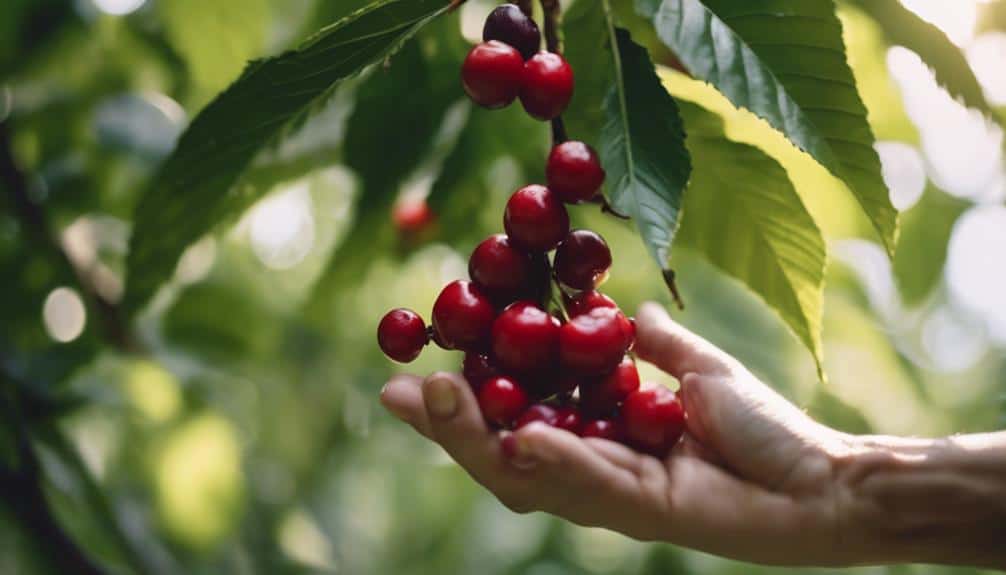
As someone who appreciates the complexities of coffee, I can't help but be intrigued by the journey of the coffee cherry. Each step in its development holds the key to discovering a world of flavors and aromas that grace our morning cups. From the careful selection of ripe cherries to the meticulous processing methods, the coffee cherry is a treasure trove waiting to be explored. Join me as we venture into the domain of coffee cherries, where secrets of taste and quality are waiting to be revealed, promising a deeper understanding and appreciation of our favorite brew.
Coffee Cherry Development Process
During the intricate process of coffee cherry development, the shift from flowering to ripening marks the pivotal stages leading to harvest. As the coffee cherries mature on the plant, they progress from green to red or purple hues, signifying their readiness for picking. The ripe coffee cherry consists of layers: the outer skin, the sweet pulp, and the coffee beans nestled within.
To extract the beans, processing methods such as pulping are employed. This involves removing the outer skin and pulp to reveal the beans inside, which are then dried to the appropriate moisture content.
Understanding the nuances of coffee cherry development is essential in producing high-quality beans. The careful management of the ripening process guarantees that the beans achieve the desired flavor profile. By monitoring the color change of the cherries and employing precise processing techniques, we can maximize the full potential of the coffee plant and deliver exceptional beans to coffee enthusiasts worldwide.
Harvesting and Transporting Coffee Cherries
When harvesting coffee cherries, it's essential to pick them at the right stage of ripeness to guarantee flavor and quality. Different varieties like Arabica require specific color cues such as deep redness to indicate readiness for harvest.
Once harvested, efficient transport methods are crucial to preserve the cherries' integrity and prevent premature deterioration.
Harvesting Process Overview
Certainly, the meticulous harvesting of coffee cherries at peak ripeness is an essential initial step in the coffee production process. Farmers carefully hand-pick the ripe cherries, which exhibit vibrant red, orange, or yellow hues. Within each cherry are two precious coffee beans, awaiting extraction during processing.
After harvesting, the cherries are swiftly transported to local mills for further processing. At the mills, skilled workers engage in meticulous hand-sorting, ensuring only the finest cherries proceed for pulping. The cherries undergo thorough washing to remove any impurities, setting the stage for the subsequent processing steps.
This critical phase of the harvesting process sets the foundation for the quality and flavor profile of the final coffee product.
Transporting Methods Used
Efficiently transporting coffee cherries from farms to processing facilities involves strategic planning and swift execution to maintain peak freshness and quality. When considering transportation methods for coffee cherries, several key factors come into play:
- Direct Delivery: Transporting freshly harvested cherries directly to processing mills guarantees the preservation of flavor and quality.
- Quick Processing: Speed is essential post-harvest to prevent spoilage and retain the cherries' freshness.
- Efficient Transportation: Utilizing trucks or containers for moving coffee cherries from farms to processing facilities ensures a smooth and timely transfer process.
Processing Coffee Cherries at Mills
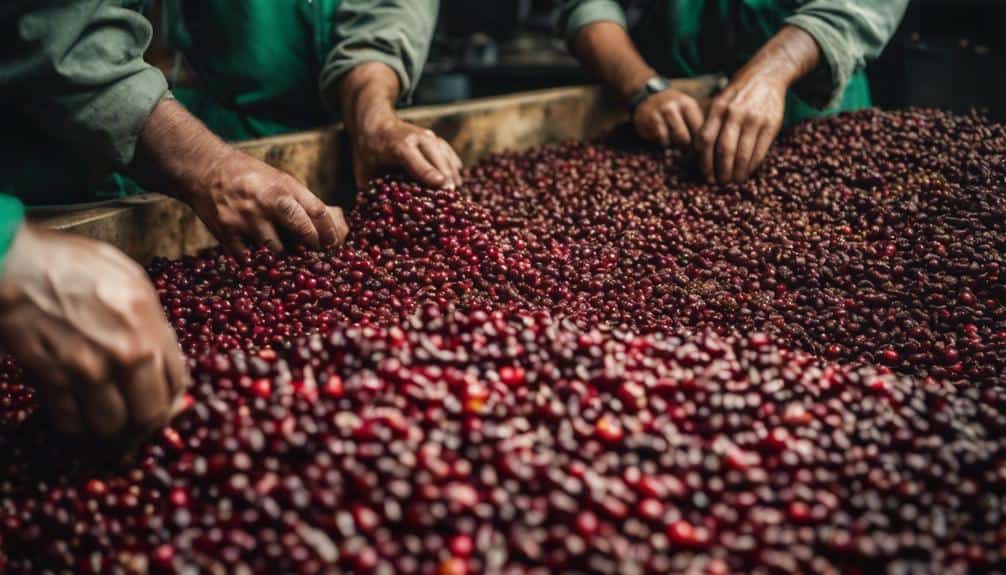
At coffee mills, the meticulous process of hand-sorting cherries is an important initial step to guarantee only ripe and defect-free cherries are processed further. This careful selection ensures that only the highest quality cherries move on to the next stages of processing.
Once sorted, the cherries undergo pulping, where the outer layers are removed to reveal the parchment surrounding the coffee beans. This step is essential for accessing the beans inside. Following pulping, a thorough washing of the cherries takes place to eliminate any remaining residues and prepare them for drying.
Processing at mills plays a significant role in shaping the flavor profiles of the final coffee beans. By subjecting the cherries to controlled sun drying on raised beds, the beans are dehydrated in a manner that enhances their flavor complexity. Each stage at the mill is crucial in ensuring that the coffee cherries are transformed into beans of exceptional quality and rich flavor.
Unveiling the Coffee Beans
The journey from coffee cherry to coffee bean is a meticulous process that reveals the essence of this beloved beverage. When uncovering the coffee beans, we initiate a transformation from the vibrant hues of the coffee cherries to the rich flavors encapsulated in the beans. Here are key aspects to ponder:
- Coffee cherries: The outer layers of the coffee cherry are carefully removed to extract the precious beans nestled within.
- Processing: Various methods are utilized to separate the beans from the cherry, ensuring the integrity of the final product.
- Roasting: The green coffee beans undergo a crucial roasting process where they develop their characteristic dark brown color and intricate flavors.
Understanding the intricacies of this shift is crucial in appreciating the diversity of coffee varietals, each producing beans with distinct sizes and flavors. Exploring the world of coffee beans reveals a spectrum of tastes waiting to be savored, offering a true liberation of the senses.
Foundation for Coffee Flavor Profile
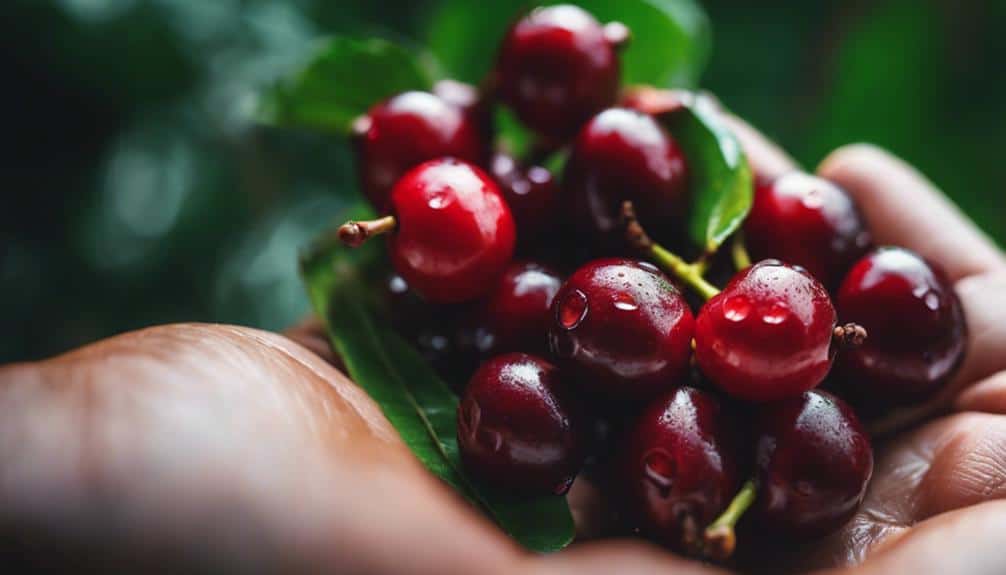
When examining the foundation for the coffee flavor profile, it's important to ponder the intricate flavor development process that starts within the coffee cherry.
The components of the cherry, like the pulp and skin, play a vital role in affecting the taste characteristics of the final brew. Harvesting and processing methods greatly influence the flavors that emerge, emphasizing the significance of the coffee cherry in shaping the diverse range of coffee profiles we enjoy.
Flavor Development Process
Exploring the intricate flavor development process of coffee cherries reveals a complex interplay of factors that shape the foundation for the coffee's distinctive flavor profile. When considering the flavor journey of coffee cherries, several key elements come into play:
- Ripe cherries at the right maturation stage offer the best potential for nuanced flavors.
- Processing methods, whether natural or washed, influence the acidity, sweetness, and body of the final brew.
- Roasting levels, from light to dark, reveal different flavor profiles inherent in the coffee cherries, adding layers of complexity to the taste experience.
Understanding these factors allows for a deeper appreciation of the art and science behind the creation of a rich and diverse coffee flavor spectrum.
Affecting Taste Characteristics
Considering the intricate interplay of factors shaping the foundation for a coffee's distinctive flavor profile, one must acknowledge the significant influence of the coffee cherry's components and processing methods on taste characteristics.
The coffee cherry's components, such as the pulp and skin, play a pivotal role in flavor development from growth to processing. Different processing methods, like natural (dry) and washed (wet), have a profound impact on the taste characteristics of coffee beans.
Natural processing yields fuller, sweeter, and more robust flavors, whereas washed processing produces coffees with clarity and vibrant notes. Examples like Fazenda Cachoeira exemplify the rich flavors of natural process coffee, while Inga Aponte highlights the distinct qualities of washed process coffee.
Understanding the coffee cherry's significance in flavor development is key to appreciating the diverse taste profiles present in various coffee beans.
Harvesting and Processing
In harvesting and processing coffee cherries, the foundation for the unique flavor profile of coffee beans is meticulously established.
- Coffee cherries should be harvested at the peak of ripeness, indicated by vibrant colors like bright red, orange, or yellow.
- The processing method chosen after harvesting, whether washed or natural, plays a significant role in shaping the final flavor profile of the coffee beans.
- The color of the coffee seed inside the cherry is a key indicator of its ripeness, ranging from greyish green to yellowish green, impacting the flavor development.
These critical steps in harvesting and processing are essential in ensuring that the coffee beans reach their full potential in flavor and quality.
Consuming Coffee Cherries: Possibilities
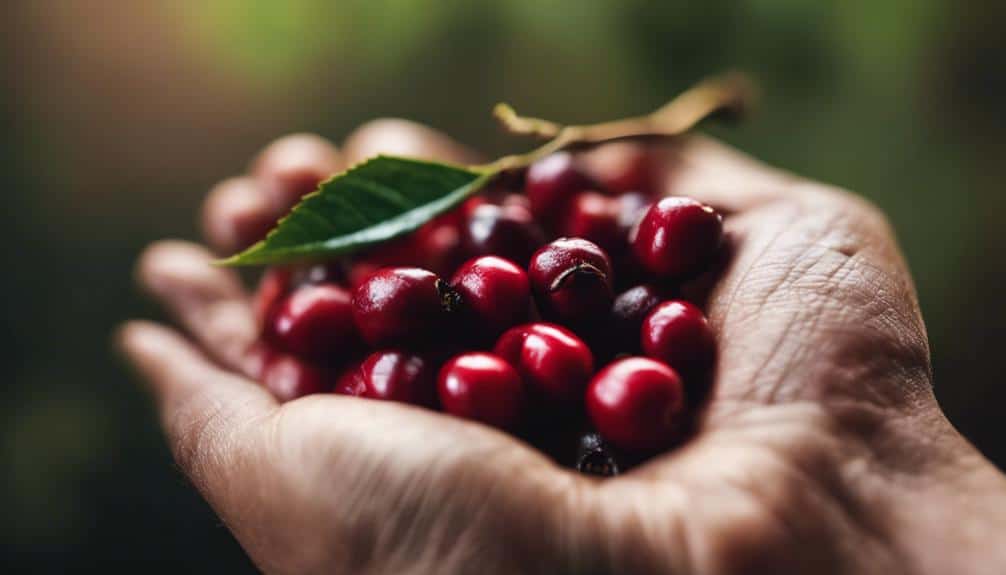
When considering the possibilities of consuming coffee cherries, one must acknowledge their unique flavor profile reminiscent of watermelon and apricot. Coffee cherries can indeed be consumed, offering a taste experience that sets them apart from the usual fruit varieties.
One intriguing example is Kopi luwak, a sought-after type of coffee made from cherries that have been eaten and excreted by the Asian palm civet. Despite their potential, the consumption of coffee cherries is limited due to their low fruit flesh content and relatively limited nutritional benefits compared to other fruits.
Although they're safe to eat, they lack the sweetness and robust nutrient profiles found in more commonly consumed fruits like berries or citrus. The possibilities of incorporating coffee cherries into culinary creations or exploring their flavor in unique ways may appeal to those seeking new and unconventional tastes.
Health Benefits of Coffee Cherry Tea
With a rich concentration of antioxidants, coffee cherry tea offers a potent blend of health benefits that can enhance overall well-being. This nutritious beverage isn't only delicious but also packed with essential compounds that support various aspects of health.
Here are three key reasons why incorporating coffee cherry tea into your routine can be beneficial:
- Antioxidants: Coffee cherry tea is abundant in antioxidants, which play an important role in reducing inflammation and protecting the body against oxidative stress.
- Heart Health: The beneficial compounds found in coffee cherry tea may contribute to supporting a healthy heart and improving blood circulation, promoting cardiovascular well-being.
- Metabolism Boost: Thanks to its caffeine content, coffee cherry tea can potentially boost metabolism and assist in weight management, offering a natural and gentle energy lift without the common jitters associated with coffee consumption.
Incorporating coffee cherry tea into your daily regimen can be a flavorful and health-conscious choice that not only tastes great but also provides a range of potential health benefits.
Storing Coffee Cherries Properly
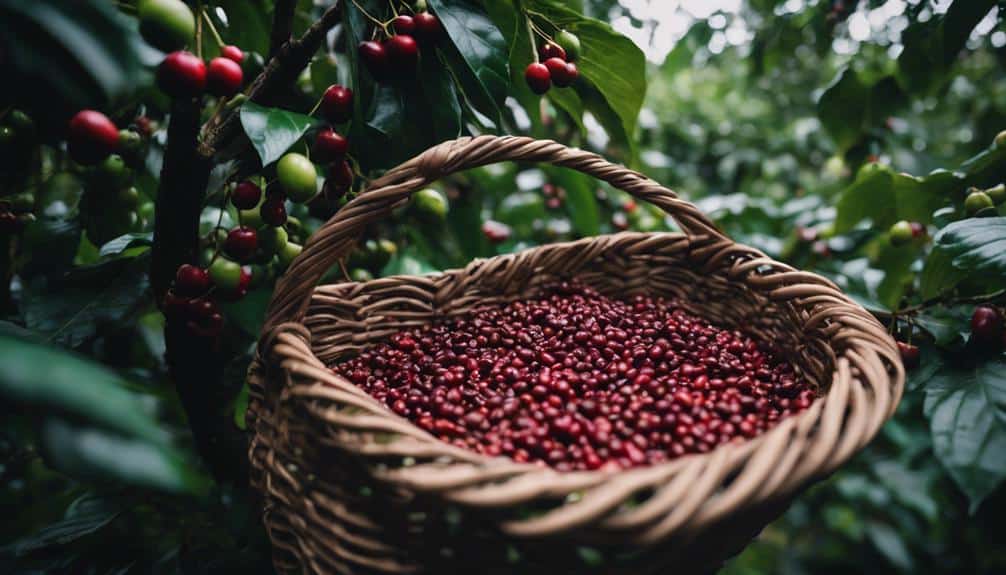
When storing coffee cherries, it's essential to keep them in a cool, dark place away from sunlight to maintain their freshness and flavor.
Utilizing airtight containers or resealable bags is vital to shield the cherries from moisture and air exposure, ensuring their quality remains intact.
To prevent flavor contamination or degradation, it's advisable to steer clear of storing coffee cherries near strong odors or heat sources.
Ideal Storage Conditions
To maintain the freshness and quality of coffee cherries, proper storage in a cool, dark location away from direct sunlight is critical. When storing coffee cherries, consider the following:
- Use airtight containers: Seal coffee cherries in airtight containers or resealable bags to shield them from moisture and air exposure.
- Avoid strong odors: Keep coffee cherries away from strong-smelling foods as they can easily absorb odors.
- Control temperature: Protect coffee cherries from heat sources and temperature fluctuations to uphold their quality and flavor.
Following these storage practices will help guarantee that your coffee cherries retain their delightful taste and aroma over time.
Length of Storage
Properly stored coffee cherries maintain their freshness and flavor for up to 2 weeks, ensuring a delightful coffee experience. When it comes to storing coffee cherries, keeping them in a cool and dry environment away from direct sunlight is important. Monitoring humidity levels is also vital to prevent mold growth, which can spoil the cherries. Consider using vacuum-sealed bags or airtight containers to extend the shelf life of your coffee cherries. While freezing coffee cherries is an option that can prolong their freshness for up to 6 months, be aware that some flavor nuances may be lost in the process. By following these storage guidelines, you can enjoy a rich and flavorful coffee experience for weeks to come.
| Stored | Cool | Dry |
|---|---|---|
| Freshness | Flavor | Aroma |
| 2 weeks | Prevent mold | Extend shelf life |
| Vacuum-sealed | Humidity | Freezing |
Sourcing Quality Coffee Cherries
Sourcing premium coffee cherries entails identifying reputable producers or vendors renowned for their exceptional quality. When seeking high-quality coffee cherries, consider the following:
- Regions: Look for coffee cherries from renowned regions like Latin America, Africa, and Asia, known for their superior coffee production.
- Handpicked: Quality coffee cherries are often handpicked at peak ripeness to guarantee the best flavor and quality.
- Direct Trade: Establishing direct trade relationships with coffee farmers can ensure the authenticity and freshness of the coffee cherries you source.
It is important to pay attention to the processing methods employed by coffee producers, as these can greatly impact the flavor and quality of the coffee cherries. By focusing on reputable sources, ideal regions, and meticulous harvesting practices, one can secure a superior coffee cherry selection for a delightful brewing experience.
Brewing Coffee Cherry Tea
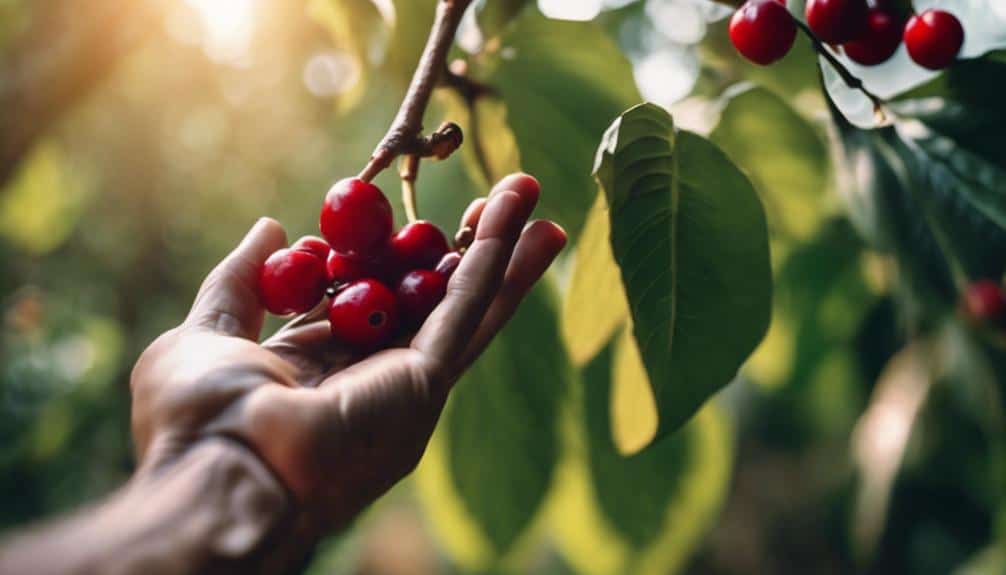
Exploring the art of brewing coffee cherry tea involves steeping dried coffee cherry skins in hot water for a flavorful infusion. The process of brewing this unique tea typically takes around 5-10 minutes to achieve perfect flavor extraction. As the dried coffee cherry skins steep, they release a naturally sweet taste with subtle hints of fruit and floral notes, creating a delightful sensory experience. What sets coffee cherry tea apart is its caffeine-free nature, offering a rejuvenating alternative to traditional caffeinated beverages like coffee or tea.
Whether enjoyed hot or cold, coffee cherry tea provides a versatile and enjoyable beverage option. Its distinct flavor profile appeals to those seeking a different kind of tea experience, one that encapsulates the essence of the coffee fruit itself. By delving into the world of brewing coffee cherry tea, one can discover a new range of flavors and aromas that celebrate the often-overlooked coffee cherry in a delightful and caffeine-free way.
Conclusion
To summarize, delving into the intricate process of exploring the coffee cherry reveals a world of rich flavors and unique profiles waiting to be discovered.
From the careful harvesting and processing techniques to the essential storage and sourcing, every step plays a vital role in shaping the taste and quality of the brew.
By focusing on these key elements, coffee enthusiasts can reveal a range of flavors and experiences that truly showcase the essence of the coffee cherry.





